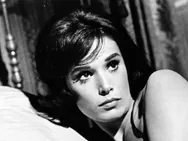The George Raft Story

Brief Synopsis
Cast & Crew
Joseph M. Newman
Ray Danton
Jayne Mansfield
Julie London
Barrie Chase
Frank Gorshin
Film Details
Technical Specs

Synopsis
George Raft, a product of New York City's Hell's Kitchen, breaks into show business as an exhibition dancer at the Dreamland Casino. He soon becomes friendly with bootleggers and gangsters and makes his living performing in syndicate-controlled night clubs. But he gets into trouble with the mob when he protects Ruth Harris, a cigarette girl, from the unwanted attentions of a racketeer. He then decides to go to Hollywood and try his luck at motion pictures. In 1932, he gets his big break by playing the role of a bodyguard in the film Scarface. As his theatrical star rises, he continues his association with well-known gangsters such as Al Capone and Benny "Bugsy" Siegel. But eventually his career fades, and he is forced to curb his big spending and give up his lavish California home. He then participates in a hotel-casino venture in Cuba. Soon after his arrival, however, the Castro revolution breaks out, and he is forced to flee. Returning to Hollywood, he makes his film comeback by once more playing a gangster--in 1959's Some Like It Hot.

Director

Joseph M. Newman
Cast

Ray Danton

Jayne Mansfield

Julie London

Barrie Chase
Frank Gorshin

Barbara Nichols

Brad Dexter

Robert Strauss

Herschel Bernardi
Margo Moore

Neville Brand
Joe De Santis
Argentina Brunetti
Pepper Davis
Tony Reese
John Bleifer
Jack Lambert
Cecile Rogers
Tol Avery
Robert H. Harris

Jack Albertson

Murvyn Vye
Crew
Jeff Alexander
Virginia Barth
Ralph Butler
Carl Guthrie
Richard C. Harris
Joseph Kish
David Milton
Alice Monte
Edward Morey Jr.
Ted Mossman
Milt Olsen
Lindsley Parsons Jr.
Monty Pearce
Norman Pringle
Alex Romero
Ben Schwalb
Norah Sharpe
Roger J. Weinberg
James West
George White
Crane Wilbur

Film Details
Technical Specs

Articles
The George Raft Story -
By Glenn Erickson

The George Raft Story -
Frank Gorshin (1933-2005)
He was born on April 5, 1933, in Pittsburgh, Pennsylvania into a family of modest means, his father was a railroad worker and mother a homemaker. His childhood impressions of Edward G. Robinson and James Cagney paid off when he won a local talent contest at 17, and that led to his first gig at 17 at a the prize was a one week engagement at Jackie Heller's Carousel night club, Pittsburgh's hottest downtown spot in the day. The taste was there, and after high school Frank enrolled in the Carnegie-Mellon Tech School of Drama did hone his craft.
His career was interrupted briefly when he entered the US Army in 1953. He spent two years in Special Services as an entertainer. Once he got out, Frank tried his luck in Hollywood. He made his film debut in a forgettable William Holden vehicle The Proud and Profane, but his fortunes picked up soon when he and when he hooked up with American Internation Pictures (AIP). With his charasmatic sneer and cocky bravado that belied his slender, 5' 7" frame, Frank made a great punk villian in a series of entertaining "drive-in" fare: Hot Rod Girl (1956), Dragstrip Girl, Invasion of the Saucer Men, and of course the classic Portland Expose (all 1957).
By the '60s, he graduated to supporting roles in bigger Hollywood fare: Where the Boys Are, Bells Are Ringing (both 1960), Ring of Fire, and his biggest tole to date, that of Iggy the bank robber in Disney's hugely popular That Darn Cat (1965). Better still, Frank found some parts on television: Naked City, Combat!, The Untouchables, and this would be the medium where he found his greatest success. Little did he realize that when his skeletal physique donned those green nylon tights and cackled his high pitch laugh that Frank Gorshin would be forever identified as "the Riddler," one of Batman's main nemisis. For two years (1966-68), he was a semi-regular on the show and it brought him deserved national attention.
By the '70s, Frank made his Broadway debut, as the star of Jimmy, a musical based on the life of former New York City Mayor Jimmy Walker. He spent the next two decades alternating between the stage, where he appeared regularly in national touring productions of such popular shows as: Promises, Promises, Prisoner of Second Street, and Guys and Dolls; and nightclub work in Los Angeles and Las Vegas.
He recently found himself in demand for character roles on televison: Murder, She Wrote, Lois & Clark: The New Adventures of Superman and film: Terry Gilliam's Twelve Monkeys (1995), and the quirky comedy Man of the Century (1999). Yet his biggest triumph was his two year stint (2002-2004) as George Burns in the Broadway smash, Say Goodnight Gracie. It ran for 364 performances and he received critical raves from even the toughest New York theater critics, proving undoubtly that he was a performer for all mediums. He is survived by his wife Christina; a son, Mitchell; grandson Brandon and sister Dottie.
by Michael T. Toole
Frank Gorshin (1933-2005)
Quotes
Trivia
Miscellaneous Notes
Released in United States Winter December 1961
Released in United States Winter December 1961














